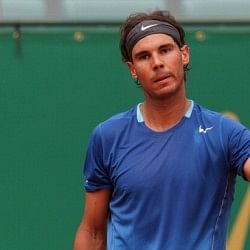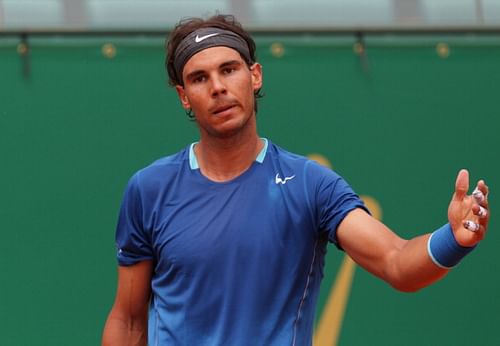
The winds of the claycourt season could change with Rafael Nadal's loss to David Ferrer

Is Rafael Nadal’s claycourt reign under threat after his Monte Carlo loss to David Ferrer?
There aren’t enough words in the English dictionary – or for that matter, even the Spanish dictionary – to sum up Rafa Nadal’s loss to David Ferrer in their quarter-final at the Monte Carlo Masters. ‘Surprising’ just doesn’t cut it, ‘agonising’ doesn’t even come close to covering it and ‘painful’ doesn’t do justice to the weirdly wonky game that the top-seed displayed in the two-hour 13-minute match.
It was evident that things were going to be different, right from the opening moments of the match. Rafa was constantly on the back-foot, something that one rarely gets to see from him on clay. And as the match progressed, that was exacerbated further by Ferrer’s tactics of picking on his backhand. Ferrer’s relentlessness allowed him to break Rafa’s opening service game for a 2-0 lead in the first set. But when it came to consolidating the break, Ferrer failed to subdue Rafa’s doggedness, and what would go on to be one of the longest games of the match – in terms of the sheer number of points played – allowed the latter to break back and bring the match back on serve.
In many ways, despite the generally one-sided nature of these two players’ rivalry, the Rafa-Ferrer match-up always makes for an interesting study. The similarity in their playing styles – predicated on agility and counterattacks – has always made for evenly matched battles, but Nadal’s superiority in almost every single aspect enables him to invariably exploit the minor chinks in the Ferrer armour, as only a player well-versed with a rival’s game can. Ferrer’s retrieving skills, impressive as they are, take a beating against Rafa simply on account of the fact that the Spanish No. 1 happens to be a better reader of the ball which, coupled with his awareness about Ferrer’s game, allows him to alter his game subtly.
But this time around, it was Ferrer who took the game to Rafa by discomfiting him with a strategy that negated the latter’s strengths while exposing his problematic areas. In the past, Ferrer used to engage in long rallies which allowed Rafa to place the ball in places that Ferrer wasn’t able to get to. Today though, Ferrer altered his game plan and it showed in the match statistics.
In rallies with less than five shots, Ferrer thrived, winning 42 points, while Rafa managed to win just a paltry 28 of them. In longer rallies extending over nine shots, Rafa held a slight edge, winning 16 points over Ferrer’s 13, but those ended up to be far and few during the course of the match.
The winner and unforced error counts were also revealing, with Rafa hitting an unprecedented 44 unforced errors to just 24 winners while his compatriot had far more respectable figures of 26 unforced errors and 22 winners respectively which demarcated the match winner quite decisively.
Rafa’s tenacity allowed him to withstand Ferrer’s constant barrages of shots to his backhand in the first set, to the extent of bringing proceedings to a dead heat taking the set to a tie-break. But what it couldn’t withstand was the way Ferrer out-thought him, creating shots with such deep angles that Rafa was left scrambling from one end to another, trying futilely to get his racquet on the ball whizzing by.
In the tie-break, Rafa won just one point and Ferrer ended up winning the set comfortably on the back of six straight points, some of them thanks to his shot-making creativity and the rest thanks to Rafa’s erratic shot placement. Up to that point, it was still salvageable. But once the second set began, it unravelled faster than anyone could have expected.
Every serve of Rafa’s was shaky even as it looked like he was finding out ways to come up with more errors. The inside-out forehand to counter the backhand-directed shots initially helped to counteract the potency of Ferrer’s intent. But when it became obvious that Rafa was going to keep continuing the same staving off tactic, Ferrer out-thought him again by keeping him guessing as to where his shots were going to be placed.
Rafa’s discomfort showed quite clearly on his face then, as if he was finally coming to terms with the fact that it would take far more resilience and perseverance to keep Ferrer at bay. When Ferrer broke him in the fifth game of the second set, it still looked conceivable that Rafa would find a way as Ferrer had choked at crucial times in the previous set when it came to consolidating breaks. As it turned out, that prediction would turn out to be both true and false.
Ferrer served for the match in the eighth game after breaking Rafa again to take a convincing 5-2 lead. But he then went on to butcher a string of seemingly simple shots, aided partly by his nerves and partly by some damage-repair quality tennis played by Rafa at the other end. At 5-4, with Rafa holding serve quite comfortably, one did expect Ferrer to choke yet again and allow Rafa a chance to creep in back into the game.
Sadly for Nadal’s fans though, the damage-repair quality tennis of Rafa came far too late for him to make necessary reparations to the match as Ferrer served it out 6-4 to defeat Rafa for the very second time – in almost a decade – on clay. It was also only the third loss for Rafa at the Monte Carlo Masters, after his loss to Argentine Guillermo Coria in 2003 in the third round and last year’s loss to Novak Djokovic in the final.
Rafa’s loss also means the potential reducing of the points’ difference between Djokovic and him to about 1,600 points in case the latter successfully defends his title. Moreover, with 2,500 more points at stake at Barcelona, Madrid and Rome before Roland Garros, this loss will add more pressure on Rafa, casting doubts about his supremacy on clay for the very first time in all the years that he’s been around.
On any other day, against the familiar backdrop of the Mediterranean waters, Rafa Nadal would have romped over David Ferrer, without missing a beat, en route to feature in Sunday finale, which has become almost a tradition thanks to his nearly decade-long presence. But in the wake of this one loss, the flow of the wind has indelibly changed. And the effects of it may even extend to the remainder of the clay season.